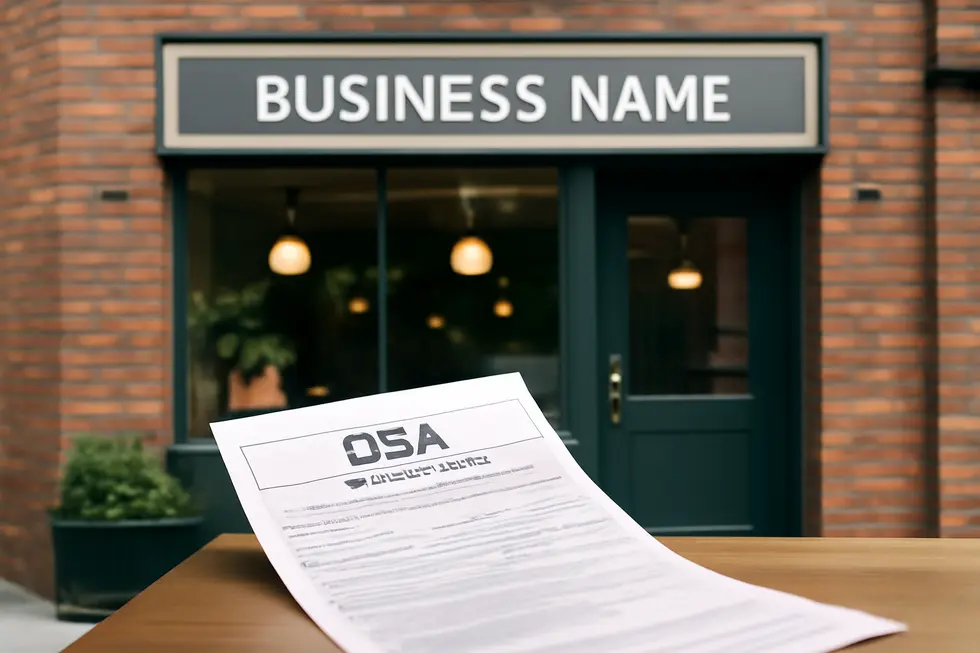Introduction
Protecting your business name is crucial to building a strong brand identity and securing your market presence. Without proper safeguards, others can misuse or copy your name, leading to loss of customer trust and costly legal battles. To ensure your business name stands firm, you must navigate several essential steps. This includes verifying the uniqueness of your name at both state and federal levels, legally registering your business entity, and filing a trademark application with the USPTO. Moreover, protecting your digital footprint by securing domain names and social media handles strengthens your brand’s online identity. Finally, local protections like registering a Doing Business As (DBA) name can supply additional security when operating under alternate business names. Each chapter unpacks these crucial facets clearly and practically, building a solid framework for lasting business name protection.
Tables of Contents
Chapter 1: How Can I Protect My Business Name by Checking Availability and Uniqueness
- Thoroughly Verifying Business Name Availability Across State and Federal Registries
- Securing Your Business Name Online: Verifying Domain and Social Media Availability to Reinforce Your Brand Identity
Chapter 2: How Can I Protect My Business Name Through State-Level Business Entity Registration
- Navigating State Registration: Securing Your Business Name Within Legal Boundaries
- Navigating the Limits of State Name Registration and Strengthening Your Brand Protection
Chapter 3: How Can I Protect My Business Name by Registering a Trademark with the USPTO
- Why Conducting a Thorough USPTO Trademark Search is Essential Before Registration
- Mastering the USPTO Trademark Application: From Search to Registration
Chapter 4: How Can I Protect My Business Name by Filing and Responding to Trademark Applications and Fees
- Mastering the Trademark Application Process to Secure Exclusive Business Name Rights
- Ensuring Lasting Business Name Protection: Managing Trademark Filings, Responses, and Fee Obligations
Chapter 5: How Can I Protect My Business Name by Securing Digital Assets Like Domains and Social Media
- Integrating Legal Rights and Digital Vigilance to Safeguard Your Business Name Online
- Proactive Brand Monitoring and Enforcement: The Key to Safeguarding Your Business Name Online
Chapter 6: How Can I Protect My Business Name by Considering a DBA Registration for Local Protection
- Harnessing DBA Registration: A Strategic Step for Local Business Name Protection
- Navigating the Legal Limits and Strategic Uses of DBA Registration for Local Business Name Protection
Chapter 1: How Can I Protect My Business Name by Checking Availability and Uniqueness

1. Thoroughly Verifying Business Name Availability Across State and Federal Registries
Protecting your business name begins with a comprehensive search to confirm its availability and uniqueness across relevant legal databases. Start by exploring your state’s official business name registry, usually hosted on the Secretary of State’s website. This registry catalogs all active business entities, including LLCs, corporations, and partnerships. By searching your proposed name—as well as close variations—you can detect existing businesses with identical or confusingly similar names locally. This crucial step prevents conflicts at the state level and ensures your entity registration will be approved.
Beyond state registries, conducting a federal trademark search is vital. The United States Patent and Trademark Office (USPTO) maintains the Trademark Electronic Search System (TESS), which documents federally registered and pending trademarks. Utilizing advanced search techniques like wildcards and phonetic variations helps identify potential conflicts nationwide. Discovering that a similar or identical name is trademarked for related goods or services early helps you avoid costly legal disputes later.
In addition to these official records, consider availability of your business name for digital use, including domain names and social media handles, which are essential for brand identity and customer engagement. Lastly, if you intend to operate under a different name than your registered business entity, check Doing Business As (DBA) name availability in relevant local databases and comply with registration requirements.
Integrating these checks minimizes the risk of choosing a name that could trigger legal challenges or brand confusion, laying a solid foundation to protect your business name locally and nationally. For a detailed state-by-state verification process, you can refer to resources such as the official Secretary of State business entity search and the USPTO’s TESS database. For more guidance on trademark protection of business names and logos, explore this comprehensive trademark protection guide.
2. Securing Your Business Name Online: Verifying Domain and Social Media Availability to Reinforce Your Brand Identity
To protect your business name effectively, it is essential to verify its availability beyond traditional state and federal business registries by extending your search to digital domains and social media platforms. Registering a matching domain name secures the primary online address where customers can find your services, establishing your brand’s presence and credibility. Use domain lookup tools to check availability, and act promptly to register not only the exact match but also common misspellings or variations to prevent cybersquatting or confusion. Additionally, domain privacy options can shield your ownership details from exposure, enhancing your control and security.
Equally important is claiming consistent social media handles across relevant platforms like Facebook, Twitter, Instagram, and LinkedIn. Uniform handles help unify your brand identity and make it easier for customers to recognize and follow your business. Conduct thorough searches on each platform, securing names even if you don’t plan to use them immediately, as this prevents others from capitalizing on your brand’s reputation.
Integrating these digital checks with your earlier state and federal searches offers a comprehensive approach to confirming your business name’s uniqueness and protecting it from infringement online. Regularly monitor these assets to maintain control, promptly renew registrations, and respond to any unauthorized use. For guidance on thoroughly checking availability and securing your digital presence, consult a detailed resource like Easyfiling’s step-by-step process.
For further insight into safeguarding your brand, exploring aspects of trademark protection for business names can be valuable. You can learn more about this at trademark protection business name and logo.
Chapter 2: How Can I Protect My Business Name Through State-Level Business Entity Registration

1. Navigating State Registration: Securing Your Business Name Within Legal Boundaries
Protecting your business name at the state level begins with registering your business entity—such as an LLC, corporation, or partnership—with the appropriate state office, usually the Secretary of State. This process establishes your business name’s legal recognition within that state and helps prevent other entities from registering the identical or confusingly similar names there. The journey starts with a thorough name availability search in the state’s database to confirm no conflicts exist. Many states offer an optional name reservation step, allowing you to hold your chosen name for a limited period, typically between 30 to 120 days, while you prepare your formation documents.
Once ready, you file formation paperwork—Articles of Incorporation for corporations or Articles of Organization for LLCs—along with the required state filing fees, which can vary significantly, usually ranging from $50 to $500. Approval of these documents results in official registration of your business under the chosen name, granting it protection against other businesses registering under the same name within that jurisdiction. If your business intends to operate under a different name than the one registered, filing a Doing Business As (DBA) name ensures local recognition for that alternate name, though it offers more limited protection.
State-level registration, while vital, covers only the jurisdiction of that state. For broader protection, especially if you operate across multiple states, federal trademark registration is essential to guard your brand nationwide. In addition, securing your digital presence by registering domain names and social media profiles matching your business name helps maintain consistent branding online and prevents others from capitalizing on your name.
Understanding the legal framework and steps involved in state business name registration is fundamental to protecting your brand identity locally. For detailed guidance on checking state-level availability and reserving your business name, visit Easyfiling’s step-by-step process. For more on naming rights protection and legal considerations, see copyright business name protection.
2. Navigating the Limits of State Name Registration and Strengthening Your Brand Protection
Registering your business name at the state level is a fundamental step to legally establish your company and gain recognition within that state. However, this protection is inherently limited. State business entity registration confines its safeguards to the borders of that state, meaning identical or confusingly similar business names can coexist legally in other states. Additionally, state registration primarily ensures that no other business registers the exact same name within the same industry locally but does not guarantee exclusivity across different markets or geographic regions. Enforcement powers at the state level are also modest, offering only limited recourse against infringement compared to federal trademark protections.
While Doing Business As (DBA) registrations can help you operate under alternative names, they do not provide exclusive rights, leaving your business vulnerable without broader protections. To bolster your business name beyond these confines, federal trademark registration is essential, granting exclusive nationwide rights and stronger legal mechanisms to prevent unauthorized use. Complementing these steps by securing your domain name and social media handles helps safeguard your brand’s digital presence from cybersquatters and confusion. If your business stretches across state lines, conducting comprehensive searches and possibly registering as a foreign entity in other states ensures better coverage.
Careful selection of your business structure and compliance with filing requirements also contribute to a solid foundation for name protection. Consulting legal counsel can provide clarity on the interplay of state registrations, DBAs, and trademarks, helping you navigate complex naming laws effectively. This multi-layered strategy strengthens your brand’s identity and resilience far beyond the limited scope of state-level registration.
For more insights about trademark protections that can supplement state registration, see our detailed guide on trademark protection for business names and logos.
You can also refer to a step-by-step process on checking name availability and state filings at Easyfiling’s business name availability guide.
Chapter 3: How Can I Protect My Business Name by Registering a Trademark with the USPTO

1. Why Conducting a Thorough USPTO Trademark Search is Essential Before Registration
Before you proceed with registering your business name as a trademark with the USPTO, conducting a comprehensive trademark search is an indispensable step. This process helps you uncover existing trademarks that may be identical or confusingly similar to your proposed name. Relying solely on a basic online search isn’t enough, as the USPTO’s Trademark Electronic Search System (TESS) or its updated Trademark Search tool provide the most authoritative database for uncovering registrations and pending applications nationwide.
When you conduct this search, focus on the exact spelling and phonetic similarities in the relevant trademark classes linked to your goods or services. The USPTO’s ID Manual is a valuable resource to correctly classify your business offerings and narrow your search effectively. A diligent review lets you detect possible conflicts early, saving you from costly application refusals and legal disputes after filing.
If you find a preexisting mark that could cause confusion, it’s wise to rethink or modify your business name before submitting your application. Some specialized legal services offer even broader searches to include federal, state, and common law trademarks, which can be beneficial if you plan to expand or operate in multiple jurisdictions.
Completing this careful search first ensures a smoother trademark registration through the USPTO’s Trademark Electronic Application System (TEAS), especially when using streamlined options available. By protecting your name through federally registered trademark rights, you solidify your exclusive use nationwide and build stronger defenses against infringement.
For step-by-step instructions to initiate your search, visit the USPTO Trademark Search page here. Additionally, for deeper insights into trademark protections for your business name and logo, explore useful information available at Trademark Protection for Business Name & Logo.
2. Mastering the USPTO Trademark Application: From Search to Registration
Protecting your business name through a USPTO trademark requires navigating a detailed, multi-stage application process that demands precision and patience. It begins with a thorough trademark search using the USPTO’s Trademark Electronic Search System (TESS) to ensure your proposed mark is not already in use or confusingly similar to others. This step prevents costly refusals and infringement disputes down the line.
Next, accurately defining the goods or services associated with your business is essential, as USPTO examines applications based on specific classification categories. Choosing the correct classes ensures your trademark covers the appropriate commercial activities and helps examiners assess your claim correctly.
Preparing your application involves crafting a clear description of your trademark and providing a specimen that demonstrates its use in commerce. You will also select your filing basis—whether your mark is already in use or you intend to use it—each with different documentation requirements.
The application is submitted online through the USPTO’s Trademark Electronic Application System (TEAS), where filing fees vary depending on the form chosen and number of classes included. After submission, a USPTO examining attorney reviews your application, during which you may receive office actions requesting amendments or clarifications.
If your application passes examination, it is published for opposition, giving others an opportunity to contest your registration. Following successful opposition or if unchallenged, your trademark enters the federal register, granting exclusive nationwide rights. Maintaining your trademark requires timely renewals and filings to keep protection active.
While the process can be complex and time-consuming—often taking over a year—federal registration offers vital legal enforcement and brand security. For a detailed filing guide, consult the USPTO Trademark Filing Guide. For additional insights on securing your business identity, explore resources on trademark protection for business names and logos.
Chapter 4: How Can I Protect My Business Name by Filing and Responding to Trademark Applications and Fees

1. Mastering the Trademark Application Process to Secure Exclusive Business Name Rights
Protecting your business name through trademark registration involves a careful and strategic process beginning with verifying that your name is unique and distinctive enough to qualify for federal trademark status. This step goes beyond simply choosing a catchy name—it requires ensuring your business name is not generic or merely descriptive without secondary meaning, as such marks are difficult to register and enforce.
Next, conducting a comprehensive trademark search is vital. Utilizing the United States Patent and Trademark Office (USPTO) database along with state trademark records and supplemental online resources helps detect any conflicting or similar marks. This thorough search minimizes risks of application denial and potential legal disputes.
Once confident in your mark’s uniqueness, filing your trademark application correctly is crucial. The application must include precise information about your business, the goods or services linked to your name, and appropriate trademark class selections. Filing fees, generally starting between $250 and $350 per class, must be paid to initiate the process. Federal registration grants you exclusive nationwide rights and legal presumptions of ownership not available through state registration alone.
Throughout the examination period, diligent monitoring of your application is necessary. If the USPTO issues Office Actions pointing out legal or procedural issues, timely and well-crafted responses addressing these concerns are essential. Responding effectively prevents rejection or abandonment and strengthens your chances for approval.
After registration, maintaining your trademark demands adhering to renewal deadlines and continuing to pay maintenance fees to preserve your rights. Vigilant enforcement against infringers safeguards the exclusivity of your business name. Considering professional legal assistance during filing and response stages can help navigate complexities and optimize protection.
For a deeper dive into these procedures, refer to USPTO official guidelines on trademark application and fees. You can also explore trademark protection for business names and logos for practical insights.
2. Ensuring Lasting Business Name Protection: Managing Trademark Filings, Responses, and Fee Obligations
Protecting your business name through trademark registration is only the start; continual attention to filing accuracy, prompt responses to USPTO office actions, and diligent fee management are vital to maintain your rights. The initial application requires precise information and payment of fees, typically ranging from $250 to $350 per class, with multiple classes or trademarks demanding separate filings and fees. Errors or omissions in this stage risk delays or outright refusal of registration.
After submission, if the USPTO raises concerns or requests more information via office actions, responding timely and correctly is essential. Failure to do so leads to abandonment of your trademark application, resulting in loss of potential legal protection. Beyond the application process, actively using your mark in commerce and monitoring the marketplace guards against infringement or confusingly similar marks that could weaken your brand’s uniqueness.
Trademark protection also demands periodic maintenance filings, including declarations of use and renewals. Missing renewal deadlines can cause your registration to lapse, stripping away the exclusive rights you’ve worked to secure. When disputes arise, being legally prepared to defend against infringement claims—such as questioning a competitor’s mark validity or exposing delayed enforcement—preserves your brand’s integrity.
As your business evolves, expanding your trademark to cover additional goods, services, or geographic areas may be necessary to shield your brand comprehensively. Alongside federal registration for nationwide rights, securing relevant domain names and social media handles supports your brand’s online presence and prevents dilution.
Consistent, proactive management of filings, responses, and fees ensures that your trademark remains a strong, enforceable shield for your business name. For detailed strategies on these steps, explore the insights on trademark protection for business names and logos.
More thorough guidance on trademark filing, maintenance, and defense is available here: How and When to Trademark a Business Name – Crazy Egg.
Chapter 5: How Can I Protect My Business Name by Securing Digital Assets Like Domains and Social Media

1. Integrating Legal Rights and Digital Vigilance to Safeguard Your Business Name Online
Protecting your business name in the digital era demands a strategic blend of legal and technological actions. First, obtaining formal rights through legal registration is essential. This starts with registering your business entity at the state level and extends to filing a trademark application with the USPTO, granting you exclusive nationwide rights to prevent misuse. Additionally, securing a Doing Business As (DBA) name provides local recognition when operating under variants of your official name.
Once your legal foundation is established, focus on claiming corresponding digital assets. Registering domain names that match your business name across key extensions like .com, .net, and .org is crucial to preclude cybersquatting. Equally important is reserving consistent social media handles on major platforms to maintain brand coherence and prevent impersonation.
To uphold this protection, implement clear internal policies governing brand usage online, guiding employees and partners on acceptable practices that preserve brand integrity. Employ automated monitoring tools to continuously scan for unauthorized uses of your name in domains, search engine listings, and social media, enabling swift action against infringement. Educating your team to recognize phishing scams or counterfeit sites further shields your reputation.
Documenting violations meticulously—capturing screenshots and links—strengthens your ability to request takedowns or pursue legal remedies. Consulting specialized trademark professionals can enhance your management of registrations and disputes.
Choosing a distinctive, non-generic trademark enhances your legal position and long-term brand strength. This comprehensive approach fuses robust legal safeguards with vigilant digital practices, ensuring your business name remains uniquely yours across all online spaces.
For detailed guidance on trademark registration and protecting your business identity, consult specialized resources like Trademark protection for business names and logos and follow step-by-step instructions at Easyfiling.
2. Proactive Brand Monitoring and Enforcement: The Key to Safeguarding Your Business Name Online
Protecting your business name through digital assets extends well beyond registration; it demands active brand monitoring and enforcement. This continuous process involves automated scanning of new domain registrations, social media platforms, and online marketplaces to detect unauthorized uses or impersonations that could damage your reputation or confuse customers. Modern AI-powered tools quickly identify suspicious activities like cybersquatting and fake profiles, enabling swift intervention before harm escalates. Effective monitoring encompasses watching trademark filings to catch conflicting registrations early, helping you stay ahead of potential threats.
When infringements occur, enforcement becomes critical. The process starts with gathering concrete, time-stamped evidence through digital tools, followed by a polite initial notification to the offending party demanding cessation of unauthorized use. If infringement persists, escalation may involve stronger legal actions to protect your intellectual property. Additionally, securing verified social accounts and registering multiple relevant domain variations fortify your defenses, while digital authentication technologies empower customers to confirm your genuine products.
This integrated approach blends strategic governance, technological infrastructure, and operational efficiency. It automates detection while aligning enforcement with legal and vendor management protocols, ensuring your brand equity remains intact in a complex digital landscape. For a deeper understanding of protecting your business name through trademark safeguards that complement digital asset protection, explore this trademark protection for business name and logo. To learn more about AI-driven brand protection solutions that provide continuous monitoring and rapid enforcement, visit BrandShield’s platform overview.
Chapter 6: How Can I Protect My Business Name by Considering a DBA Registration for Local Protection

1. Harnessing DBA Registration: A Strategic Step for Local Business Name Protection
A DBA (Doing Business As) registration offers a practical way to protect your business name on a local scale by allowing you to formally use a trade name distinct from your legal entity name. This registration is crucial when you want to operate under a more marketable or memorable name without forming a new legal entity. It legally records your chosen business name at the state or local level, helping to prevent others in that jurisdiction from using the exact same name, thus reducing local duplication and confusion.
While a DBA gives you the flexibility to brand your business effectively and comply with regulatory requirements, it does not provide exclusive rights or any trademark-level protections. This means that the same DBA name could potentially be registered by a different business in another state or locality, and it does not shield you from infringement beyond your registration region. For more comprehensive legal protection nationwide, particularly if your brand carries significant value, pursuing trademark registration is essential to secure exclusive ownership and legal remedies.
Leveraging a DBA is especially beneficial for sole proprietors or partnerships who want to present a professional or distinct business identity without the complexity of forming an LLC or corporation. To maximize local protection, you should register your DBA with the correct county or state office and diligently check name availability within your area to avoid conflicts. Ultimately, a DBA registration provides a foundational layer of name protection and legal compliance locally but works best when combined with trademark registration for broader brand security.
For a detailed understanding of DBA registration and business name protection, refer to this comprehensive guide on legal business names.
2. Navigating the Legal Limits and Strategic Uses of DBA Registration for Local Business Name Protection
Registering a Doing Business As (DBA) name is a common step for businesses seeking local identification beyond their formal legal names. However, it is crucial to understand that a DBA registration primarily allows a business to operate under an alternate name but does not confer exclusive legal rights or trademark protection. This means that others may register or utilize the same DBA name within the same jurisdiction if it is not federally trademarked, limiting the scope of protection it provides.
DBA registrations are subject to local or state uniqueness requirements to prevent confusion, yet these restrictions apply only within that jurisdiction’s boundaries. For example, a DBA registered in one state may be available to another business in a different state, which can lead to marketplace overlap if unchecked. Additionally, DBAs must be periodically renewed; failure to do so could forfeit your right to use the name. Importantly, DBAs cannot include terms such as “Inc.” or “LLC” unless your business structure matches those designations.
Strategically, DBAs serve well for marketing and professional branding, offering flexibility without the complexity of forming new legal entities. To enhance local name protection, thorough searches for existing business names and trademarks should precede any DBA filing to avoid infringing on others’ rights. For robust protection, combining DBA registration with state-level entity formation and federal trademark registration creates layered safeguards for your brand. Since DBA regulations vary widely by state, consulting local filing requirements and legal guidelines is essential.
For a deeper understanding of how trademark registration complements DBAs in protecting your business name, see the detailed guidance on trademark protection for business names and logos.
For comprehensive steps on name availability and filing your DBA, visit Easyfiling’s guide: https://easyfiling.us/check-business-name-availability/
Final thoughts
Protecting your business name requires a multi-layered approach that combines legal registration, trademark protection, and digital asset management. Starting with thorough checks for name availability ensures you avoid costly conflicts from the outset. Formalizing your business entity solidifies your local legal standing, while securing a federal trademark with the USPTO delivers the broadest and most powerful protection nationwide. Filing and managing trademark applications properly avoid delays or refusals, and securing your online presence keeps your brand consistent and safe in the digital realm. Finally, local measures such as DBA registration offer additional safeguards when operating alternate trade names. Through these strategic steps, business owners can confidently protect their brand, preserve reputation, and sustain growth. Taking proactive action today builds a strong foundation for your business’s future.
Your IP is the foundation of your success—let’s protect it together before it’s too late. We can’t wait to help you turn your ideas into legally secured assets.
About us
undefined


